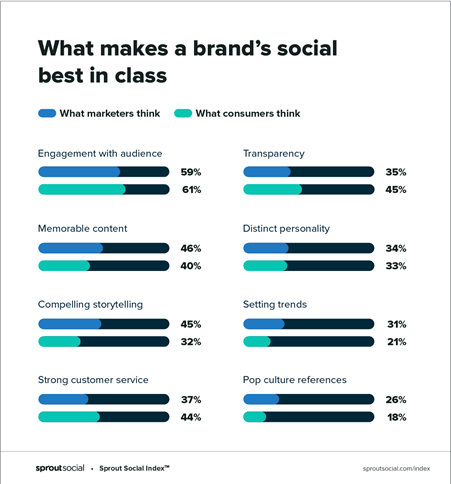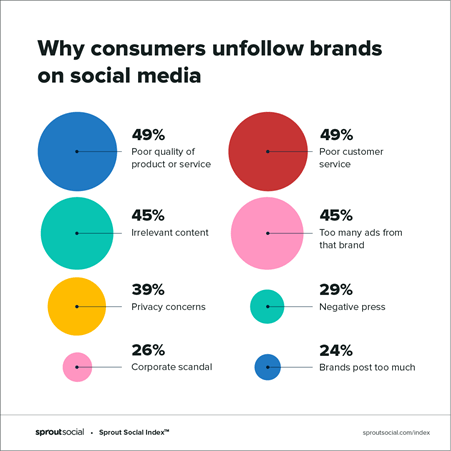If your brand was a person, how would they speak? This is the premise of brand voice. It is an integral part of branding that defines how you communicate with your audience.
We love this article by Sprout Social that discusses brand voice:
In branding work, people often think about how a brand looks visually, from fonts to colors to design styles. What is sometimes overlooked is brand voice. With the inclusion of social media in marketing efforts, brand voice has become more important than ever as a way to stand out from the crowd of digital chatter.
Even if you’re unfamiliar with the term, you have likely experienced it. The company who sells surf gear takes on the vocabulary and attitude of a surfer. The tween clothing company loosens up its language and uses common slang to connect to their target audience. While you can get away without having a distinctive brand voice, you can take your marketing much further once you’ve established one.
Let’s go further into the details on what brand voice is and how you can develop one of your own.
What is brand voice?
Brand voice is the distinct personality a brand takes on in its communications. Imagine you went to a dinner party and you’re chatting with all the guests. One person stands out because they’re great at storytelling in a distinctive, unique way. The flow of their words, the language they used and their personality all combined to make for a memorable experience. In fact, when you’re retelling that story, you immediately think of that person.
Now extrapolate that dinner guest into a brand voice. Who is your brand online? If your brand was a person, what personality traits would they take on and what would they actively avoid? What phrases and stylistic choices does your brand use on a consistent basis?
All of the above combine to create your brand voice. This personality is applied to everywhere your brand speaks, including newsletters, social media posts, internal official communications like company announcements and advertising.
Why does brand voice matter?
Why should you care about your brand voice? Why not just write whatever you want in whichever style you feel like that day?
The digital landscape is crowded. It’s filled with chatter from brands and individuals alike. You can only stand out so much on the basis of your visual content, logo or product features alone. Your written content needs that same attention and consistency you give to the other elements of your brand presence.

Brand voice helps you stand out from the crowd. In the Sprout Social Index, the consumers surveyed had reasons why some brands stood out more than others. Forty percent said memorable content, 33% said distinct personality and 32% said compelling storytelling. In all three of these aspects, brand voice plays a significant role. You can’t have a distinct personality without a distinct brand voice.

Content is not just about photos or videos. It includes words and graphics. How you present yourself is important to consumers. The same Index researched why consumers unfollow brands on social media. Forty-five percent of consumers cited irrelevant content. Posting content that doesn’t match your brand’s perceived style is one way of getting your account unfollowed.
Lastly, brand voice matters because you want your brand to be consistent and recognizable. Brand awareness succeeds when you can identify a brand only by their content before you even see who posted it.
5 Tips for developing your brand voice
So now that the importance of brand voice has been established, how the heck do you even develop a distinctive one? Use the below five tips to get started on figuring out what your brand voice is.
1. Document everything & be consistent
Just like your visual brand guide and your social strategy, your brand voice needs documentation, too. Unless you have one person managing all communications and marketing, a brand voice document will be helpful for multiple departments. It exists as a reference for anyone who writes in the brand’s voice. It keeps social media posts and marketing copy in check and consistent.
The document should begin with your company’s core values and mission statement. You should be able to pull some defining personality traits from these statements.
Other components of the document include the personality traits, common vocabulary, brand phrases and most importantly, examples. You want to write out plenty of examples that demonstrate both how to write within your intended brand personality and what types of choices fall too far outside of your defined style.
2. Audit your current voice
Need some inspiration on what your brand personality should be? Take a look at your current communications. Make sure you grab examples from all communications so you get a good overview of what the voice is like currently.
You may find that your voice is inconsistent because of different writers or uses of certain words over others. Note how your target audience interacts with you and how they speak. What voice traits do your top-performing posts and newsletter issues have in common?
From here, you’ll be able to note what your brand’s personality currently is and then begin the process of brainstorming more traits that you want to emulate.
3. Identify your audience and personas
Another way of formulating your brand voice is by seeing who your audience and marketing personas are. If your target audience is younger, you’ll want to use language that resonates with them. Using language familiar to an older generation will only serve to alienate your younger audience.
As you work through your audience and personas, list out traits and common vocabulary you want to take on as a brand. A West-coast brand with a West-coast target audience will take on regional slang.
A piece of advice: don’t stray too far away from your brand’s current operations. You want to present your voice authentically and not robotically or give the appearance of just chasing trends.
4. Know your tone
Brand voice is what you say and brand tone is how you say it. Your tone may vary between audiences, so it’s a good idea to document when to use certain tones in certain situations.
The excited way you announce a new product won’t be the same tone you take on when responding to a customer complaint. Identify common scenarios you come across as a brand and categorize them into the different tones you would take on.
5. Review & adapt
Developing a brand voice is not a one-time effort. It should be reviewed and refined at designated times, such as once a year or during major branding overhauls, and during major events that significantly alter your company’s marketing strategy. Language evolves and the words you used five years ago might not be en vogue today. Without a consistent check in on your brand voice, you risk sounding out of date or out of touch with current events.
For example, GIF usage in social media wasn’t as mainstream today as it was five years ago. But they’ve evolved into common acceptance and are now easily accessible on most of the major social media platforms.
Branding by Somer Design
Does your logo and branding need an upgrade? We specialise in branding and can help you to enhance the way you connect with your audience. Throughout the design, development, and marketing process, our clients don’t just gain premium branding materials and online assets, but they also learn a lot about their business and their purpose.
Learn more about our branding services.




